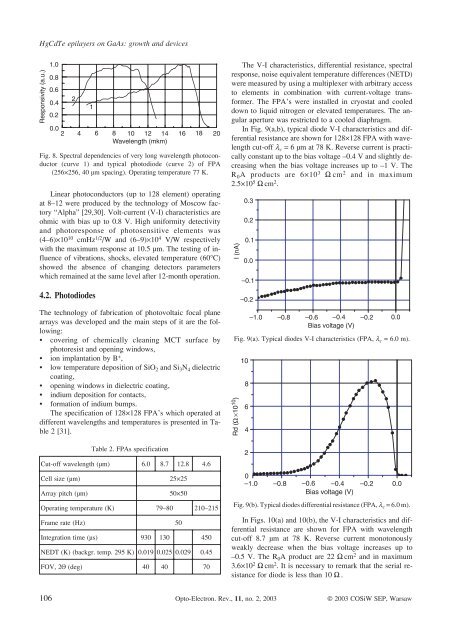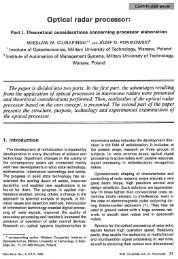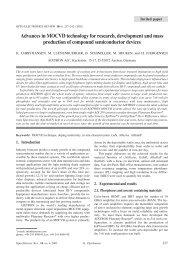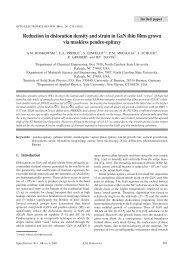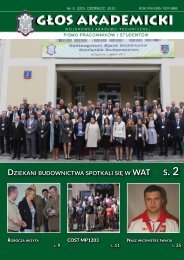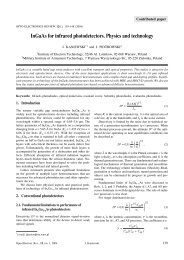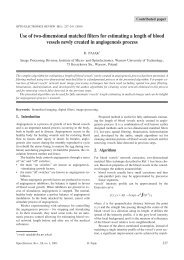HgCdTe epilayers on GaAs: growth and devices
HgCdTe epilayers on GaAs: growth and devices
HgCdTe epilayers on GaAs: growth and devices
You also want an ePaper? Increase the reach of your titles
YUMPU automatically turns print PDFs into web optimized ePapers that Google loves.
<str<strong>on</strong>g>HgCdTe</str<strong>on</strong>g> <str<strong>on</strong>g>epilayers</str<strong>on</strong>g> <strong>on</strong> <strong>GaAs</strong>: <strong>growth</strong> <strong>and</strong> <strong>devices</strong>Fig. 8. Spectral dependencies of very l<strong>on</strong>g wavelength photoc<strong>on</strong>ductor(curve 1) <strong>and</strong> typical photodiode (curve 2) of FPA(256×256, 40 µm spacing). Operating temperature 77 K.Linear photoc<strong>on</strong>ductors (up to 128 element) operatingat 8–12 were produced by the technology of Moscow factory“Alpha” [29,30]. Volt-current (V-I) characteristics areohmic with bias up to 0.8 V. High uniformity detectivity<strong>and</strong> photoresp<strong>on</strong>se of photosensitive elements was(4–6)×10 10 cmHz 1/2 /W <strong>and</strong> (6–9)´10 4 V/W respectivelywith the maximum resp<strong>on</strong>se at 10.5 µm. The testing of influenceof vibrati<strong>on</strong>s, shocks, elevated temperature (60°C)showed the absence of changing detectors parameterswhich remained at the same level after 12-m<strong>on</strong>th operati<strong>on</strong>.The V-I characteristics, differential resistance, spectralresp<strong>on</strong>se, noise equivalent temperature differences (NETD)were measured by using a multiplexer with arbitrary accessto elements in combinati<strong>on</strong> with current-voltage transformer.The FPA’s were installed in cryostat <strong>and</strong> cooleddown to liquid nitrogen or elevated temperatures. The angularaperture was restricted to a cooled diaphragm.In Fig. 9(a,b), typical diode V-I characteristics <strong>and</strong> differentialresistance are shown for 128×128 FPA with wavelengthcut-off l c = 6 µm at 78 K. Reverse current is practicallyc<strong>on</strong>stant up to the bias voltage –0.4 V <strong>and</strong> slightly decreasingwhen the bias voltage increases up to –1 V. TheR 0 A products are 6×10 3 Wcm 2 <strong>and</strong> in maximum2.5×10 5 Wcm 2 .4.2. PhotodiodesThe technology of fabricati<strong>on</strong> of photovoltaic focal planearrays was developed <strong>and</strong> the main steps of it are the following:• covering of chemically cleaning MCT surface byphotoresist <strong>and</strong> opening windows,• i<strong>on</strong> implantati<strong>on</strong> by B + ,• low temperature depositi<strong>on</strong> of SiO 2 <strong>and</strong> Si 3 N 4 dielectriccoating,• opening windows in dielectric coating,• indium depositi<strong>on</strong> for c<strong>on</strong>tacts,• formati<strong>on</strong> of indium bumps.The specificati<strong>on</strong> of 128×128 FPA’s which operated atdifferent wavelengths <strong>and</strong> temperatures is presented in Table2 [31].Fig. 9(a). Typical diodes V-I characteristics (FPA, l c = 6.0 m).Table 2. FPAs specificati<strong>on</strong>Cut-off wavelength (µm) 6.0 8.7 12.8 4.6Cell size (µm) 25×25Array pitch (µm) 50×50Operating temperature (K) 79–80 210–215Frame rate (Hz) 50Integrati<strong>on</strong> time (µs) 930 130 450NEDT (K) (backgr. temp. 295 K) 0.019 0.025 0.029 0.45FOV, 2Q (deg) 40 40 70Fig. 9(b). Typical diodes differential resistance (FPA, l c = 6.0 m).In Figs. 10(a) <strong>and</strong> 10(b), the V-I characteristics <strong>and</strong> differentialresistance are shown for FPA with wavelengthcut-off 8.7 µm at 78 K. Reverse current m<strong>on</strong>ot<strong>on</strong>ouslyweakly decrease when the bias voltage increases up to–0.5 V. The R 0 A product are 22 Wcm 2 <strong>and</strong> in maximum3.6×10 2 Wcm 2 . It is necessary to remark that the serial resistancefor diode is less than 10 W.106 Opto-Electr<strong>on</strong>. Rev., 11, no. 2, 2003 © 2003 COSiW SEP, Warsaw


